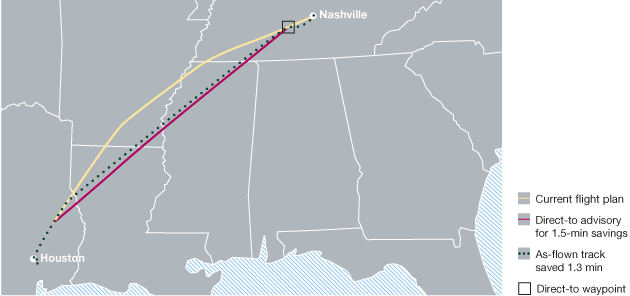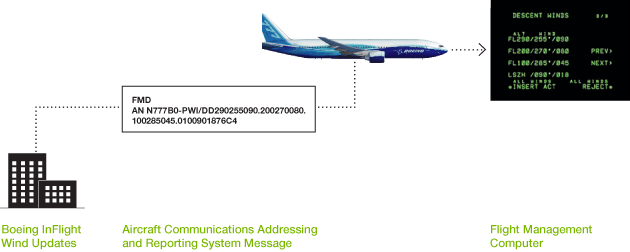

Boeing has developed a new type of flight services that enables operators to increase fuel and flight efficiency and reduce costs and carbon emissions.
A new suite of applications helps airlines optimize their postdeparture flight operations.
Boeing InFlight Optimization Services (InFlight) is a suite of applications that continuously checks an array of real-time air traffic, weather, and airplane data to uncover postdeparture opportunities for individual flights to save fuel and improve operational performance.
This article describes the development of InFlight by Boeing Flight Services, how it works, and how airlines can benefit from its use.
Development of InFlight Optimization Services
With fuel expenses representing up to 30 percent of an airline’s annual operating budget, reducing fuel use remains one of the best ways for airlines to cut costs. Airlines typically use roughly 10 percent more fuel than necessary due to flight and air traffic inefficiencies. So implementing even small per-flight efficiency improvements can deliver significant fleetwide savings during the course of a year.
Capturing these savings was the impetus for developing InFlight. This suite of products provides live, actionable flight-specific airline advisories, resulting in efficiency improvements for postdeparture operations. InFlight, which is offered as a subscription service, is available for an airline’s modern fleet, including non-Boeing airplanes.
How InFlight works
InFlight continuously monitors each flight’s progress to identify emerging efficiency opportunities — configured to airline specifications — and automatically sends advisories to the airline. The ground-based service optimizes individual flights by addressing real-time air traffic control (ATC) system variables, the airplane’s current flight trajectory, flight management computer (FMC) data, weather conditions, and other factors. The information is up to date to within seconds.
InFlight communicates flight-specific advisories to an airline’s operations center or directly to the flight deck in a format that can be immediately loaded into the FMC or acted upon by flight crews. It was developed with a common infrastructure to accommodate growth of new flight optimization service applications. The software is designed with common core services and functionality while enabling data sharing across multiple products.
InFlight services are implemented within current air traffic and airline operating procedures using existing communication channels. No regulatory changes and little or no new equipment or training are required, so airline savings begin immediately.
InFlight currently comprises two services: Direct Routes and Wind Updates. Each service provides up-to-the-minute information to airline operation centers and flight crews, enabling adjustments en route to account for weather and ATC status. The Direct Routes service is currently available in the continental United States while the Wind Updates service is being implemented worldwide.
Direct Routes: Automatic flight-optimizing alerts
Airlines always aim to develop and file the most efficient flight plans possible. However, these predeparture filed flight plans are constrained to procedurally separated jet routes and en-route transitions to and from standard departure and arrival routes. Currently, after airplane departure and with traffic permitting, pilots can make a verbal request to ATC for direct-to routings to downstream waypoints in the current flight plan, eliminating inefficient dog-legs in the en-route phase of flight.
InFlight Direct Routes automates this process. Direct Routes software continuously searches for simple, ATC conflict-checked, wind-optimal reroute opportunities that offer at least one minute of time savings within the next hour of flight (see fig. 1).
Figure 1: Direct Routes flight optimization
InFlight Direct Routes provides simple, ATC conflict-checked, wind-optimal reroute opportunities with at least one minute of time savings within the next hour of flight.

Direct Routes alerts an airline’s operations center or flight crew when a more fuel-efficient path that could be approved by the controller opens up along the route of flight. To increase the likelihood of ATC approval and to keep air traffic controller workload to a minimum, the advisories are prechecked for traffic conflicts, convective weather, established airspace constraints, and other factors. Finally, the pilot must contact ATC to request the direct-to clearance for the more fuel-efficient flight path.
The current Direct Routes system only covers airline operations within the continental United States. The U.S. Federal Aviation Administration (FAA) is providing the live high-update rate surveillance data necessary to monitor the airline’s operation and check for ATC conflicts on any proposed Direct Routes advisories. Boeing has shared details of the project and findings from Direct Route trials with the FAA to ensure the advisories are compatible with airspace procedures and constraints, and are complementary to ATC services. Operational testing of Direct Routes has been completed, and this service is available to customers.
Initial Boeing projections show that Direct Routes can save more than 40,000 minutes of flight time per year for a medium-sized U.S. airline — the equivalent of operating hundreds of flights that use no fuel and produce no emissions.
Wind Updates: Real-time FMC wind updates
Historically, flight crews have received weather forecasts and flight plan weather information prior to a flight and manually entered the en-route and descent winds data into the FMC before departure. The forecast information can be several hours old by the time an airplane pushes back from the gate. And, although these weather reports provide general forecasts of winds, temperature, and pressure within a region, they do not include FMC inputs precisely tailored for current as-amended flight paths.
The InFlight Wind Updates system calculates the most accurate FMC input to best represent the updated wind and temperature for the flight trajectory and for the unique capabilities of the FMC on that airplane. The system utilizes the number of weather bands available on the FMC and determines the flight levels for the weather bands based on the specific wind and temperature profile. Currently, descent wind updates are available for the Next-Generation 737, 777, MD-11, and A330. Wind Updates for the 747, 757, 767, 787, and A320 family will be available soon.
The use of old, inaccurate, and limited weather data — especially wind and temperature data — can prevent airplanes from operating at their most efficient flight-management-system settings and prevent them from meeting precisely established arrival times (increasing fuel burn through additional use of speed brakes and descent level offs). Correcting even small inefficiencies in postdeparture wind updates adds up to significant fleetwide savings during the course of a year.
InFlight Wind Updates identifies optimal input settings while the airplane is in flight and proposes updates to specific FMC weather parameters when there is a sufficient net economic benefit (see fig. 2). After review and acceptance by the flight crew, the wind updates are autoloaded into the FMC. This updated weather information in the airplane FMC enables a more efficient and effective trajectory prediction as a component of en-route and descent flight planning, such as improved computation of step climb decisions, speed schedules, and the top of descent point. Boeing projects that Wind Updates users will experience potential savings of 100 to 200 pounds (15 to 30 gallons or 55 to 110 liters) of fuel for just the descent portion of a typical single-aisle airplane flight (see fig. 3). Boeing is currently conducting operational trials with two major airlines to further expand the capabilities of this service.
Figure 2: Wind Updates flight optimization
InFlight Wind Updates continuously monitors airline operations and proactively uploads descent winds when beneficial.

Figure 3: InFlight Wind Updates benefits
In this example, which assumes a net increase in tailwind (or decrease in headwind) since the flight plan was generated, the airplane can save 150 pounds of fuel using InFlight Wind Updates to optimize the FMS from top of descent to landing. Fuel saving data is based on analytical models, simulator sessions, and flight trials.

Summary
Most airlines are not fully optimizing their postdeparture flight operations. There are several new approaches to optimize in-flight trajectories, including updating the FMC with an intelligent selection of the most current and accurate wind information, and continuously monitoring each flight for wind-optimal “direct-to” opportunities to shorten flight paths. Boeing InFlight Optimization Services is a suite of applications that automate these processes, offering postdeparture opportunities for individual flights to save fuel and improve operational performance.
For more information, please contact Mike Durham or email airlineeffiencyservices@boeing.com.

